4. BioChromes¶
Research¶

When we started the week, I was happy to deepen my knowledge in natural dyes, as I had already learnt a few technics, such as natural dying, eco-print and screen printing with natural dyes. I also discovered new ways of doing it and it made me want to explore more and go further.
I could use the colour research as a base for the costume part of my project related to performance.
References & Inspiration¶
I'm getting inpired by the book Webs of Power from Starawhk, that is an ecofeminist witch and an activist. She talks about reshaping the economy through global and local actions. The fact of using what is in our surrounding (such as plants or kitchen wastes or recicled materials) is already making a step in the production of an art piece. The ecofeminist movement that has taken some time to be in the light in France has now a bit more visibility. It has been always judged as non coherent movement for the academics, as many of the texts, cultures and subcultures that were talked about were supposingly not proved scientifically.
Making magic colours with plants may not save the planet but it connects me more to the ancient knowledge of plants that we have been saving throughout history.
Readings (from Charlotte aka Marga)
David SANTANDREU Michel GARCIA : dyer quoted by Charlotte (he really has a lab, mad scientist of the dye) Mathieu - FRESH from Lyon Big training centre in the south of France - Couleur Garance - created by Michel GARCIA Vocabulary
Lexicon Dyeing : It is the application of colouring molecules on a support. Engallage : It is the action of soaking the fibres in a decoction of tannin plants. Specific processes
Vegetable dyeing Dyeing of an animal/protein fibre Dyeing of a vegetable / cellulosic fibre Screen printing Pigments Eco Print Vegetable inks Experiments
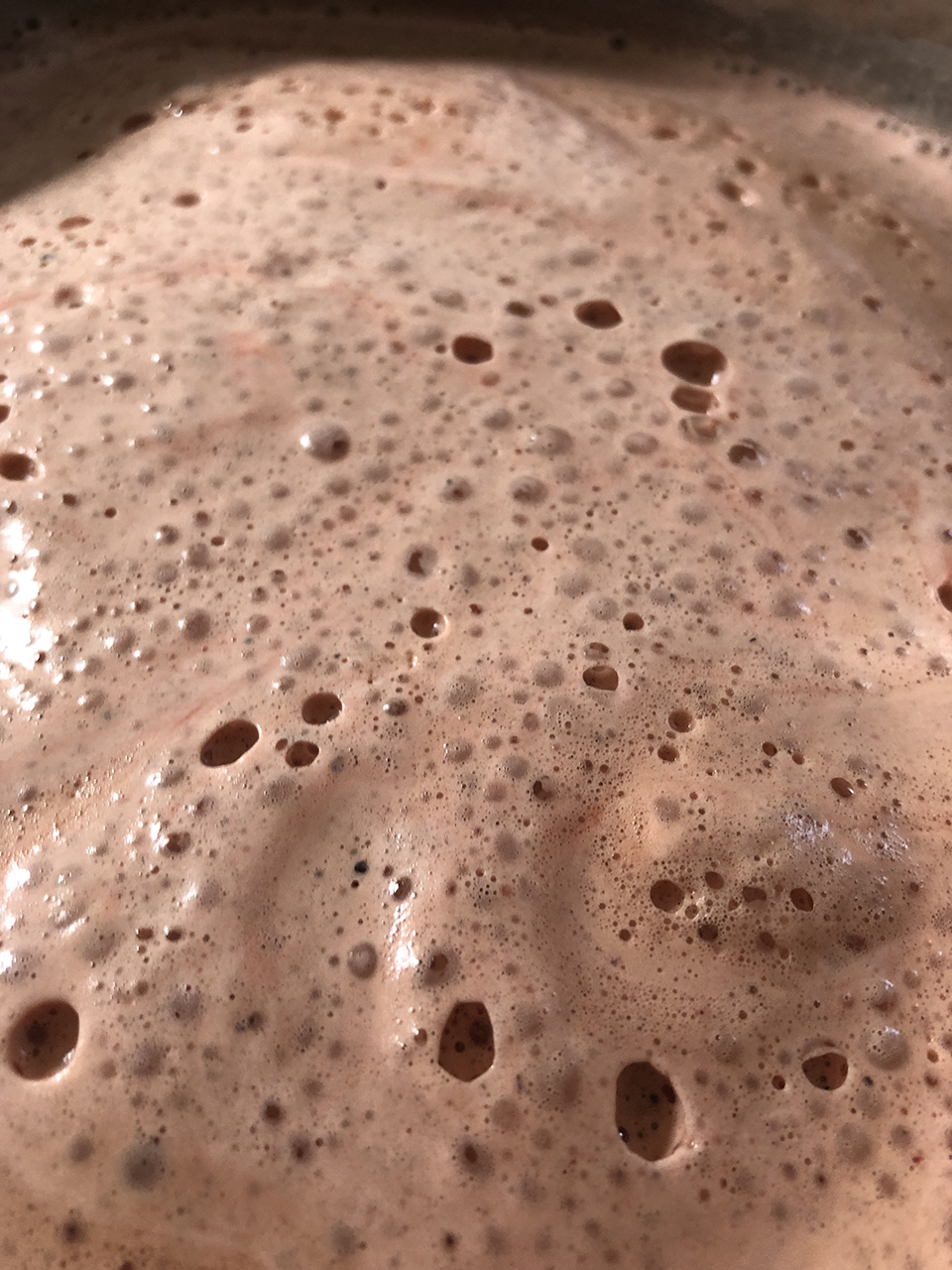
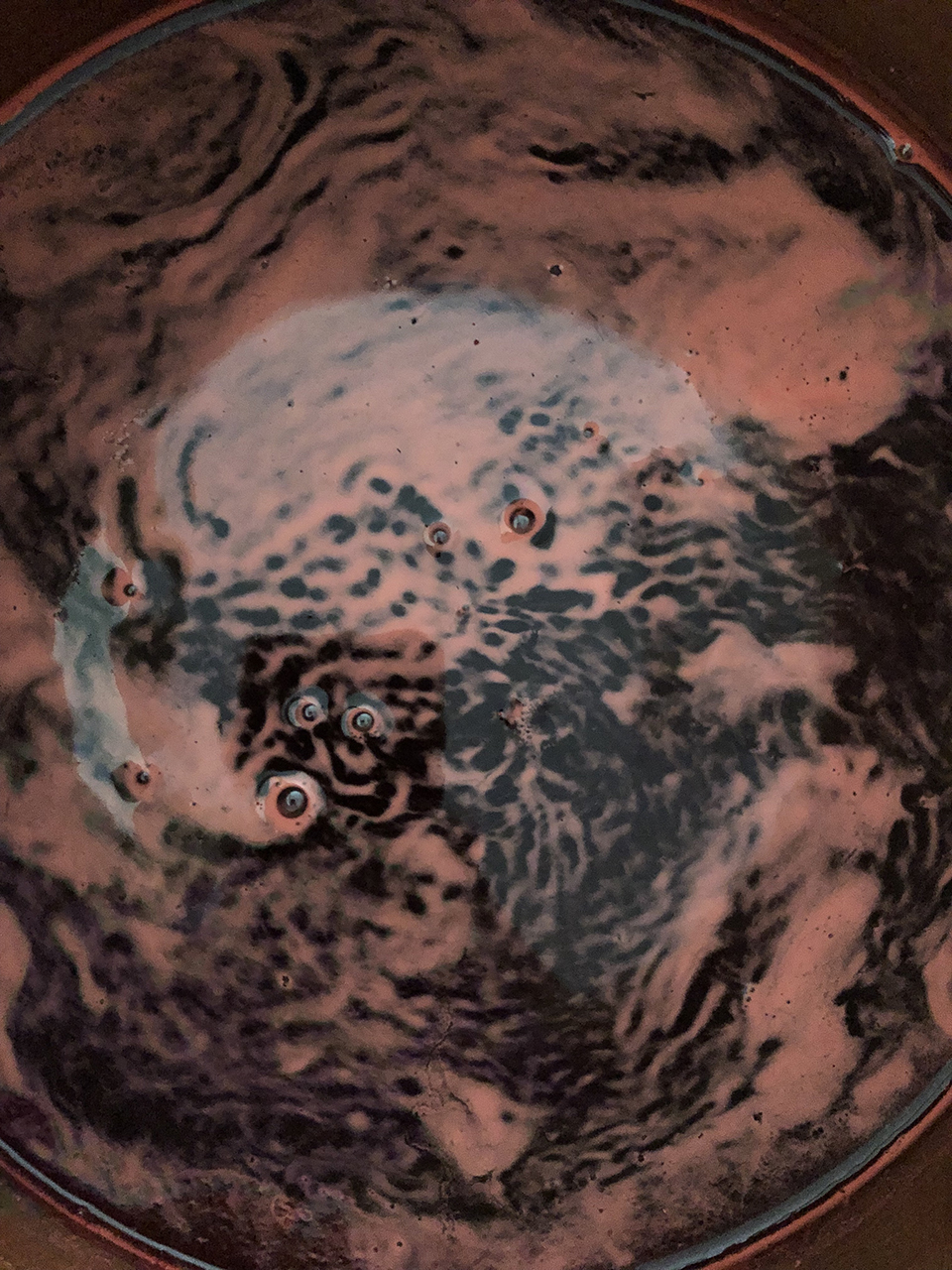
I also wanted to keep working on the character that I am creating. A figure of a sort of creature-goddess with multiple inspirations and powers. I will used this material research for her costume and set design.
General informations¶

We received Marga Creations this week for a deep dive into natural dyes.
A lot of knowledge was lost when people switched to synthetic dyes. Plant colors used for fabric, cosmetics, hair etc. but doesn't work for anything that has to be baked like pottery.
A lot of plants contain color molecules, huge variety of different molecules Plants can be used only on vegetal fibers (cellulose-based - cotton, linen, hemp, rayon, stinging nettle...) and animal fibers.
Tinctorial plants (plantes tinctoriales) We're going to look for the more solid (stable?) molecules, not going to get into ephemeral dyes.
3 more stable plants: madder, reseda, marigold (calendula)
3 primary colors:
- red: garance (madder)
- yellow: reseda (réséda)
- indigo: many different plants
Reference Book: "Le monde des teintures naturelles" by Dominique Cardon.
Preparing the fibers¶

To receive color, fibers need to be opened. It is hard to get raw fibers locally, generally buy them already prepared "apprêt" (primer?) already applied, which prevents color to bind with the fibers many baths with savon de Marseille are necessary to get the fiber back in its natural state, can take months Lessive de cendre (wood ash, prepared from sumac, oak, walnut, chestnut tree...) is very good for preparing cellulosic fibers to be dyed To make it you soak ash in water for several hours then filter out the solids Very basic (alkanine) so toxic for human Problem is that woods contain tannins, which dyes the fibers. Goal is to find woods that don't dye fiber a lot. Oak has a lot of tannins but doesn't dye a lot so it's the best, walnut colors too much Sap trees are too acid. Never take a fabric just bought and try to dye it.
Mordanting¶
Most plants need help to hold on the fibers in time A few plants are "plantes substantives" like rhubarb root (yellow), rumex (yellow), eucalyptus (orange) have oxalic acid and don't need mordanting for animal fibers (oxalic acid binds to protein in the fibers), they can also be used as mordants for other colors. They're not used a lot and only on animal fibers, not cellulosic fibers
For animal fibers, wool and silk, need alum, which is a metal. Most used is "alun de potassium" (potassium alum). Can be bought in crystals but can also be found in some plants to have 100% plant-based dyeing process: lycopodes, symplocos, prêle To extract alum from the plants you make a decoction. These plants have a bit of color too (generally yellow) Then you heat the fibers in an alum bath Need to weigh the dry fibers first of all, and weigh the potassium alum Ratio depends of the result you want, how strong you want the color to be, but a good ratio in 20% to 30% Can also add some cream of tartar (5%) in addition to the alum for wool Leave to soak at 90° for 2 to 3 hours then air it and let it dry a bit
The more you let the fibers dry between mordanting and dyeing the deeper the color will be and the more the color will stay
For cellulosic fibers you do a mordanting bath and then you add tannins Tannins add nuances to the fibers, they have a color ; without tannins, colors have bad lightfastness on cellulosic fibers Add protein to the fiber (so used on cellulose fibers and not animal fibers because they already have a lot of protein) Gall nut (noix de galle) very concentrated in tannins, 50% tannins, and don't color much (a little off white) Tannin bath left to heat for about an hour 30% plant or 10% tannin extract for the weight of the fibers for 100g fibers, need around 3 litres of water
Iron is also a mordant, iron sulfate Alum lights up the color, iron darkens it Take rusty nails and leave it in vinegar for one month to make nail soup
Alunage + engallage
Lightfastness test: control sample in the dark, test sample left in the sun for 12 days Washfastness test: try washing with dishsoap. Rubbing fastness: try rubbing the fabric by hand for 10 minutes.
Preparing the substrates¶
Cutting rectangles of woven:
- cotton
- linen
- silk
Also:
- wool (carded unspun wool)
Linen and cotton
30% alum 384 g linen 30% = 115g alum 10% tannin = 38 g water 3l/100g = 11 l
350 g cotton 30% = 105 g alum 10% tannin = 35g 11 l
Mordant cotton and linen together in one pot
Wool 35g 30% = 8.5g alum
Silk 43 g 30% = 12.9 g alum
Mordant wool and silk together in one pot
Iron can be used as a mordant but also to add nuances to color, for instance with yellow dye it'll create green
Tannin+iron reaction becomes instantly very dark Gall nuts with iron will already make a black color.
Inks¶


Going to use the leftovers from the tannin bath to make inks Using iron in combination with the gall nut extract to make a black color
Iron not great on wool or silk because it damages the fiber
We'll use a printing technique from India with printing paste:
For printing we'll Make Acetate as a mordant For alum (acétate d'alumine) :
- 1l vinegar for 100g alum (or 60g alumin sulfate which is easier to dissolve) + 50g cristaux de soude (that help the alum dissolve)
-
For acétate de fer, same recipe but with 60g de sulfate de fer
-
Add gomme de guar to make the liquid into a paste (for textile)
- About 1% and has to be dissolved quickly to avoid lumps For paper other subtances can be used (agar agar, wax...)
🥽 Same weight between acetate and plant juice. Ingredients: - 50g alumina or iron acetate - 50g dye liquid - Thickeners : o Guar gum o Waxes o Gelatine o Rice flour o Or any other thickener Utensils : - Beaker - Balance - Mixer 🥽 When the inks are used on the textile you need to steam for 1h to fix them. The inks are less solid / less resistant than the printing paste.
This paste is applied to the fabric, then let it dry, the fabric will be like cardboard where it's printed
The print, made in mordant, will be invisible
At this point we can do a wheat bran bath for the fabric Removes the mordant surplus
Then we dunk the fabric in a dye bath and the color will only hold where the mordant was applied
David Santandreu Good reference for Natural Dye.
Adding color directly in the printing paste will make an ink.
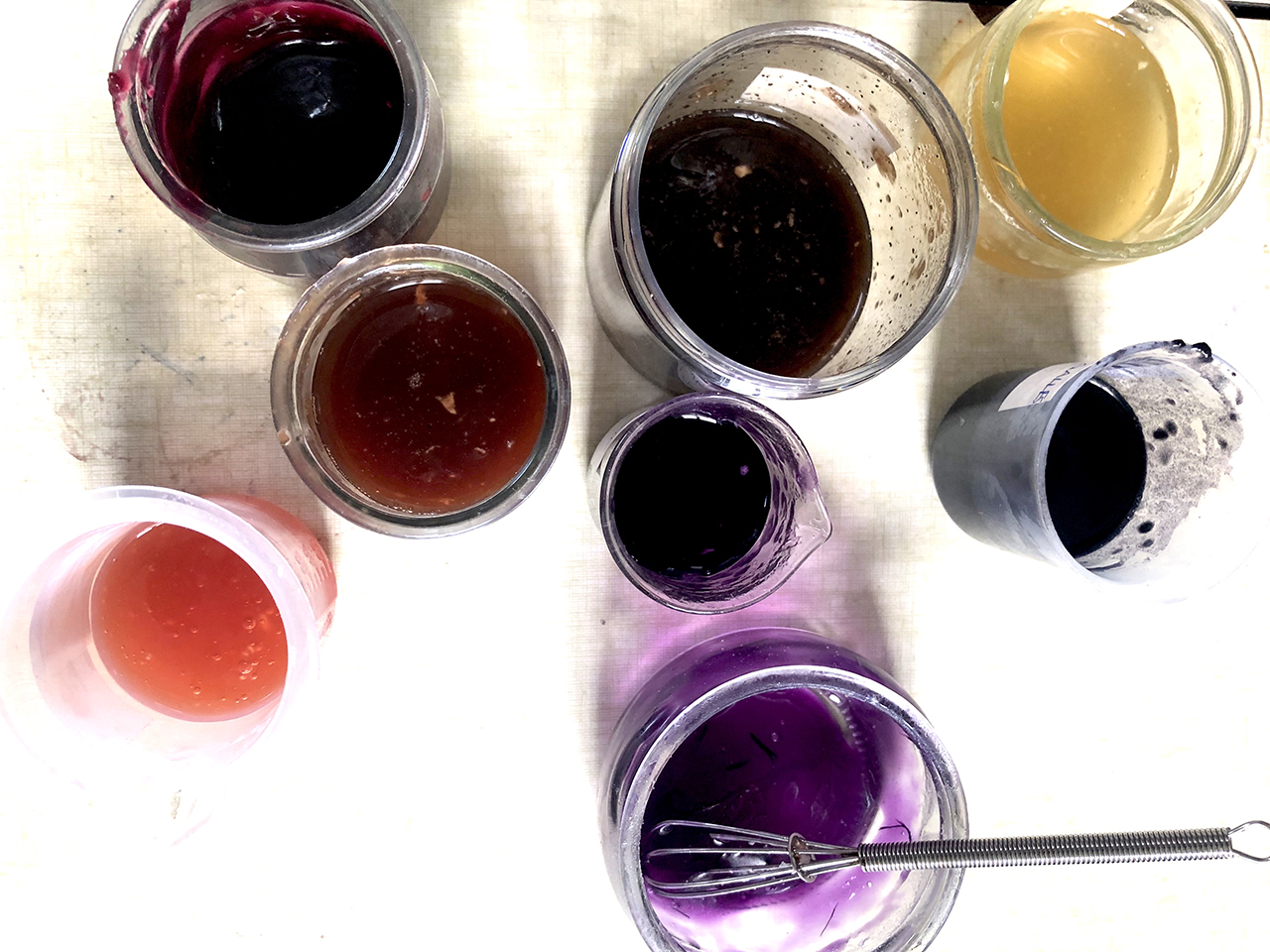
Screen printing¶
The canvas is coated with a photosensitive product which, after exposure, allows the ink to pass only on the exposed surface.
Silk-screen printing is widely used for its resistance and ease of production.
Preparation utensils : - Spoons - Beaker - Maryse o Bowls
Printing tools : - Screen printing frame pre-insulated - Squeegee - Iron or alum printing paste - Colour juice from the dye bath
1 - Making your printing paste
It is made with iron or alumina acetate. The two must not be mixed. The plates must be cleaned well after use.
Alumina acetate : - 200ml vinegar 10/12% (the higher the acidity, the better) - 12g alumina sulphate - 10g soda crystals - Guar gum powder
Iron acetate : - 200ml 10/12% vinegar (the higher the acidity, the better) - 12g iron acetate - 10g soda crystals - Guar gum powder
Preparations: - In a beaker, pour the vinegar, then the alumina or iron sulphate, then the soda crystals.
- Mix everything well, there should be no lumps left.
- Add the guar gum gradually according to the desired texture.
Wheat bran = removes excess bite, absorbs impurities.
2- PRINTING
- Position the fabric under the frame
- Spread the paste on the screen printing frame where you want to print it. Squeegee the paste through well. silkscreen_printing_mordant.mp4
- Air dry (can be accelerated with a hair dryer)
- Soak the fabric in wheat bran ideally
- Soak in the colour bath
- Dry in the shade! Beware of multiple dips, do not mix the different baths.
The pigments¶
Ingredients:
20g of alum 5g of soda crystals 200ml of filtered colour juice Utensils: 3 beakers with high rims (the reaction may foam afterwards) 3 spoons 1 funnel 1 mortar and pestle 1 maryse 1 balance 1 piece of cotton to filter the pigment 1 dehydrator Do not mix the spoons as you go along. The amount of water depends on the saturation of the alum as you mix.
Preparation:
1 - Weigh the solid ingredients: alum and soda crystals. 2- Dilute them separately with hot water (Alum needs more time to dissolve) 3- Pour 200ml of filtered coloured juice into the high rim beaker 4 - Add the diluted alum to the beaker 5- Gently add the soda crystals and mix 6- Leave to stand for several hours, until 2 phases appear (a liquid and a solid phase) 7- Place the cotton ball in the funnel to recover the solid phase 8- Leave to filter for several hours/days 8- Collect the precipitate (solid phase) with a clean spoon 9- Put in a dehydrator 10- Grind it with a mortar and pestle Long conservation of the pigment in a hermetic support. Pigments dissolve in oil, not water.
Documenting experiments¶
Garance, oignon and Campeche samples:
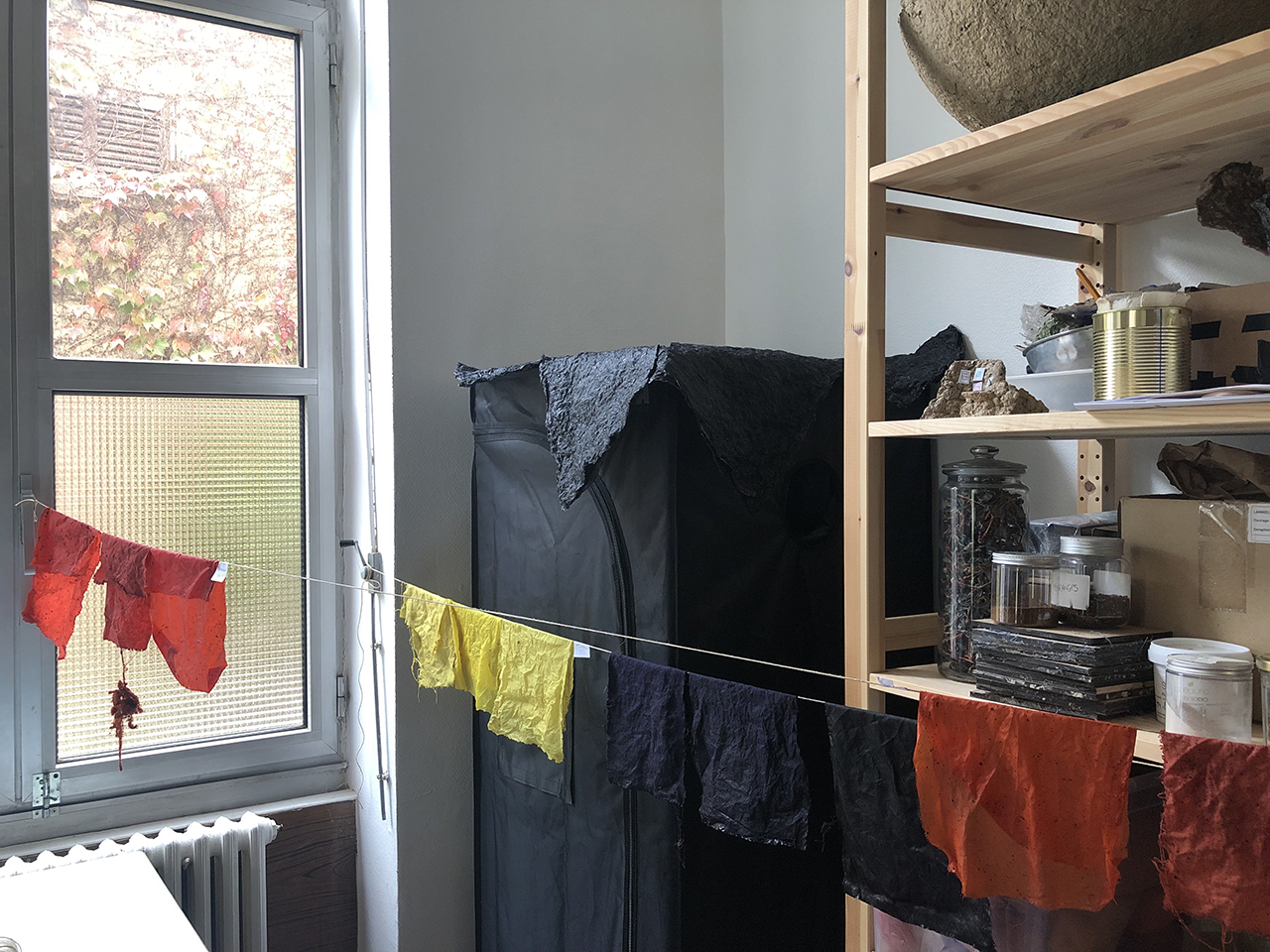
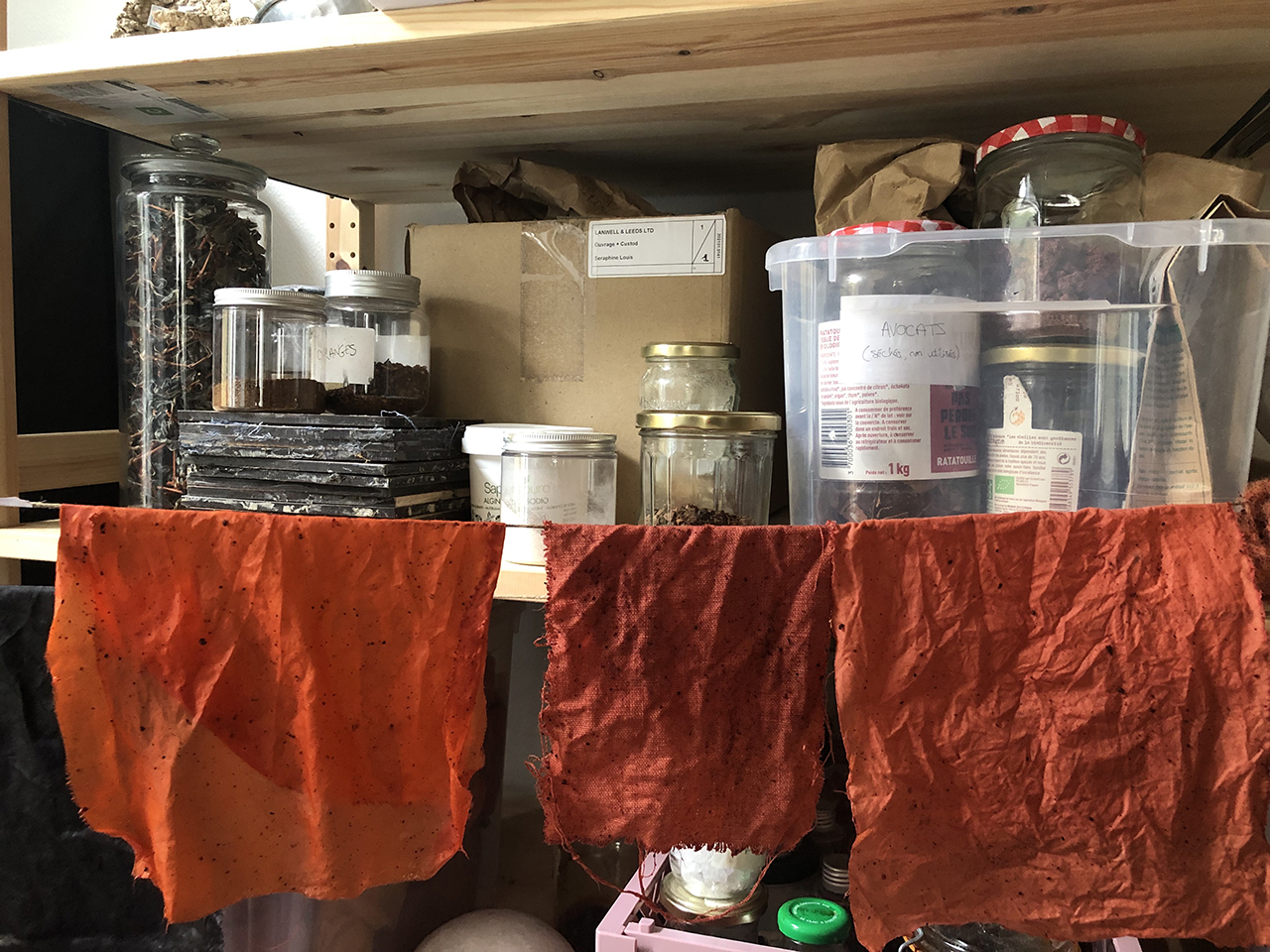
Campeche wood and alum screen printing solution:
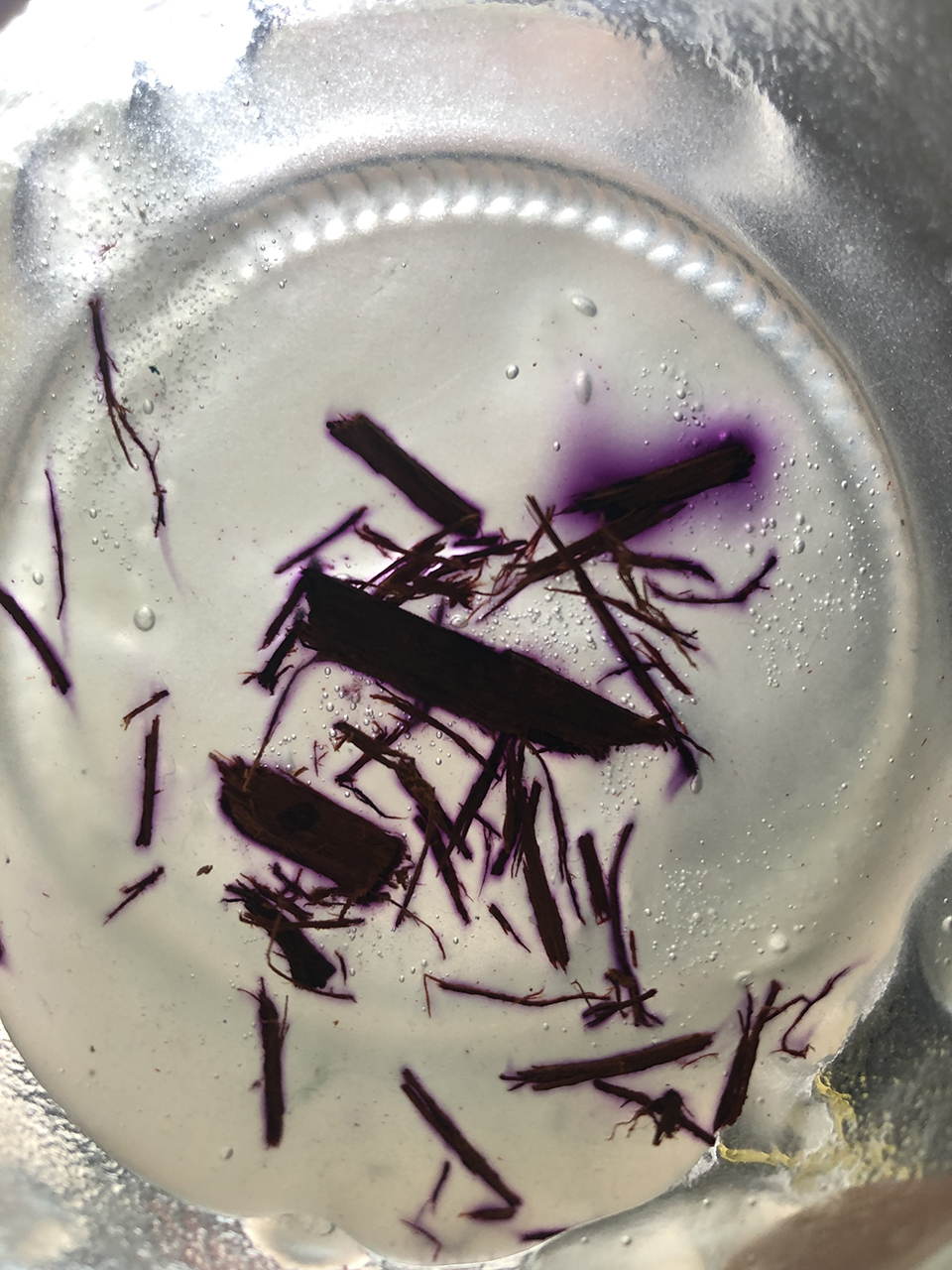
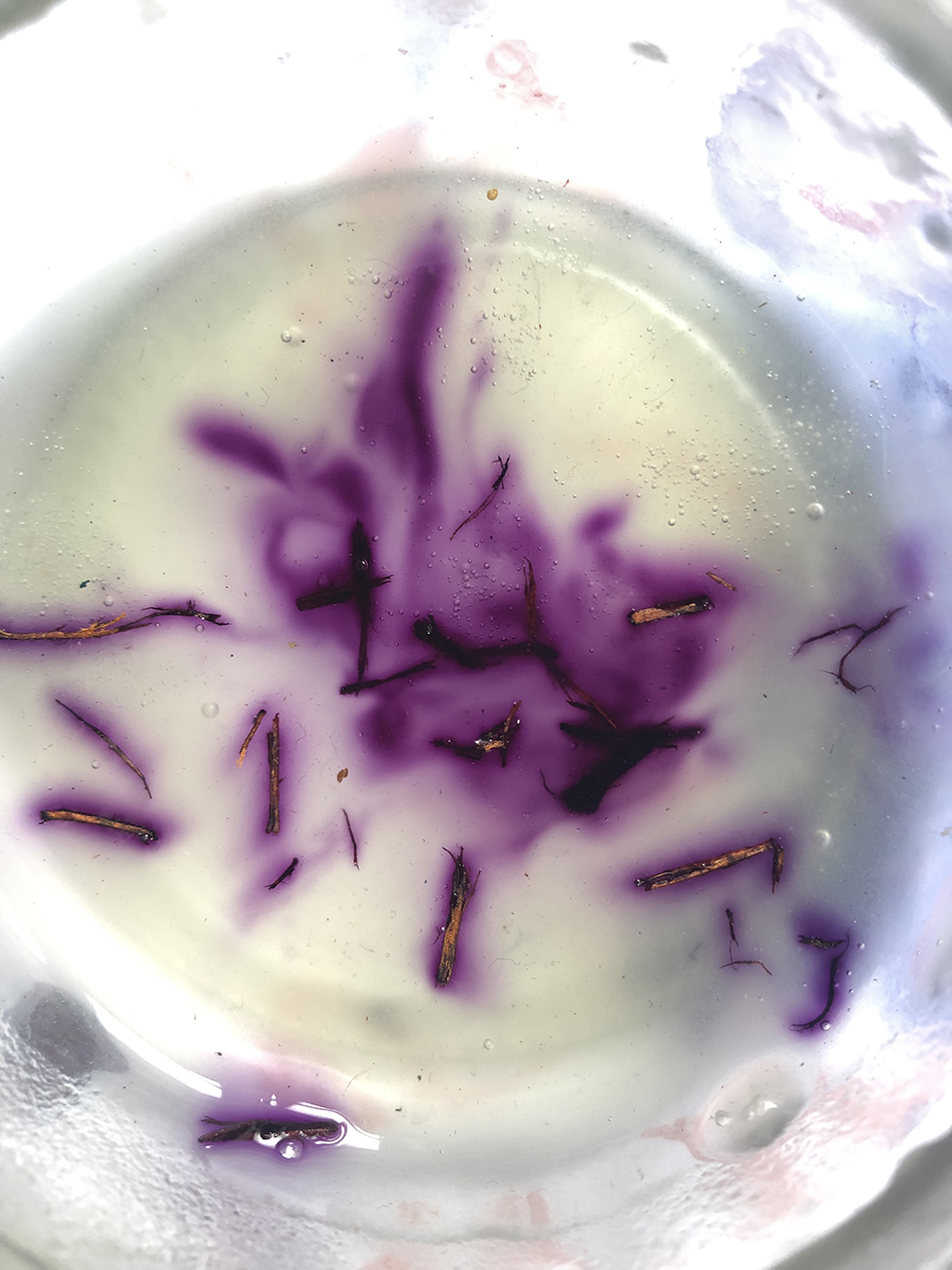
Preparation of plants from the garden for Ecoprint:
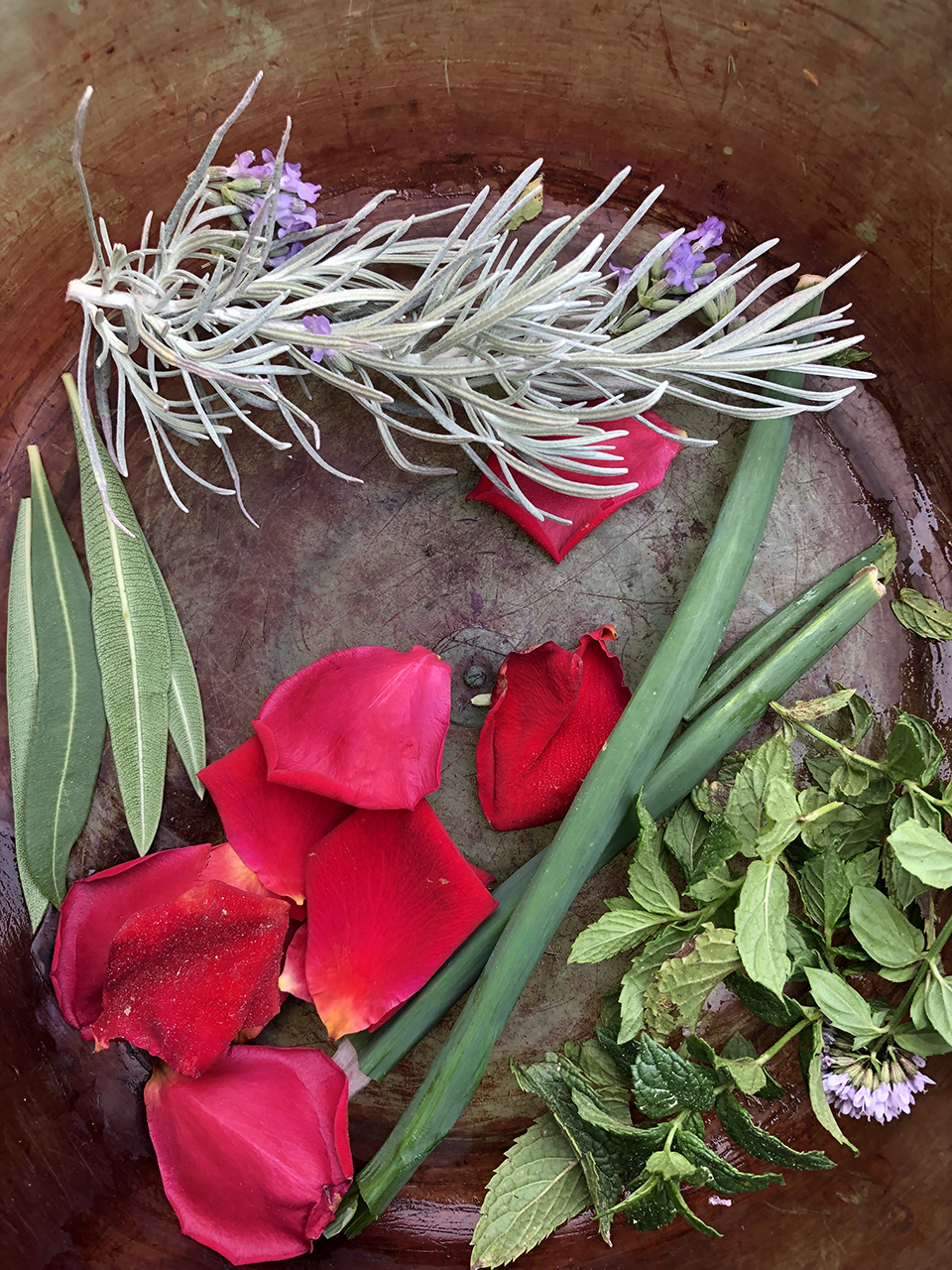
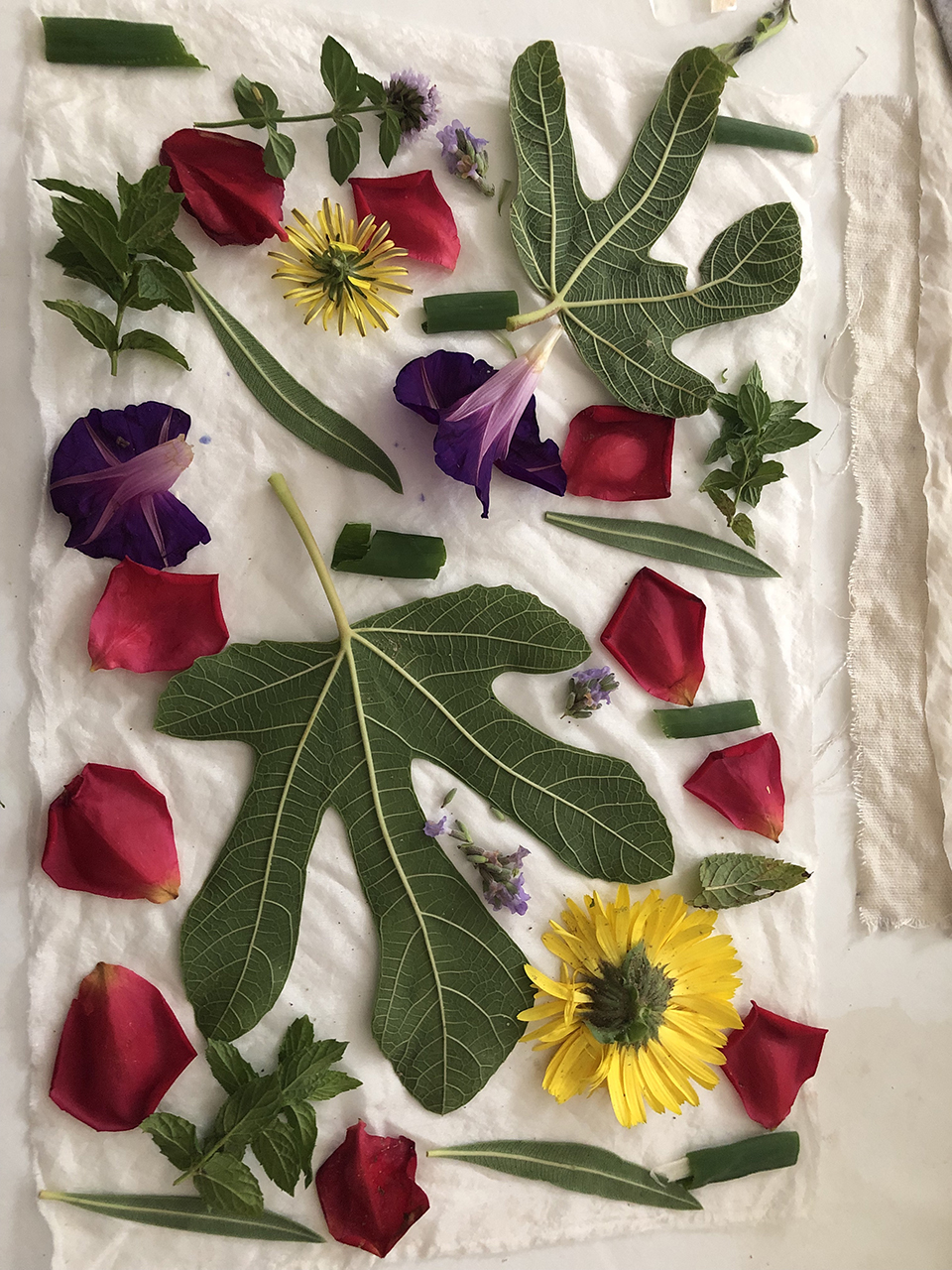
Ecoprint roll once the fabric is vapored on linen and silk and cotton and then once it is finised on cotton:


RESULTS¶



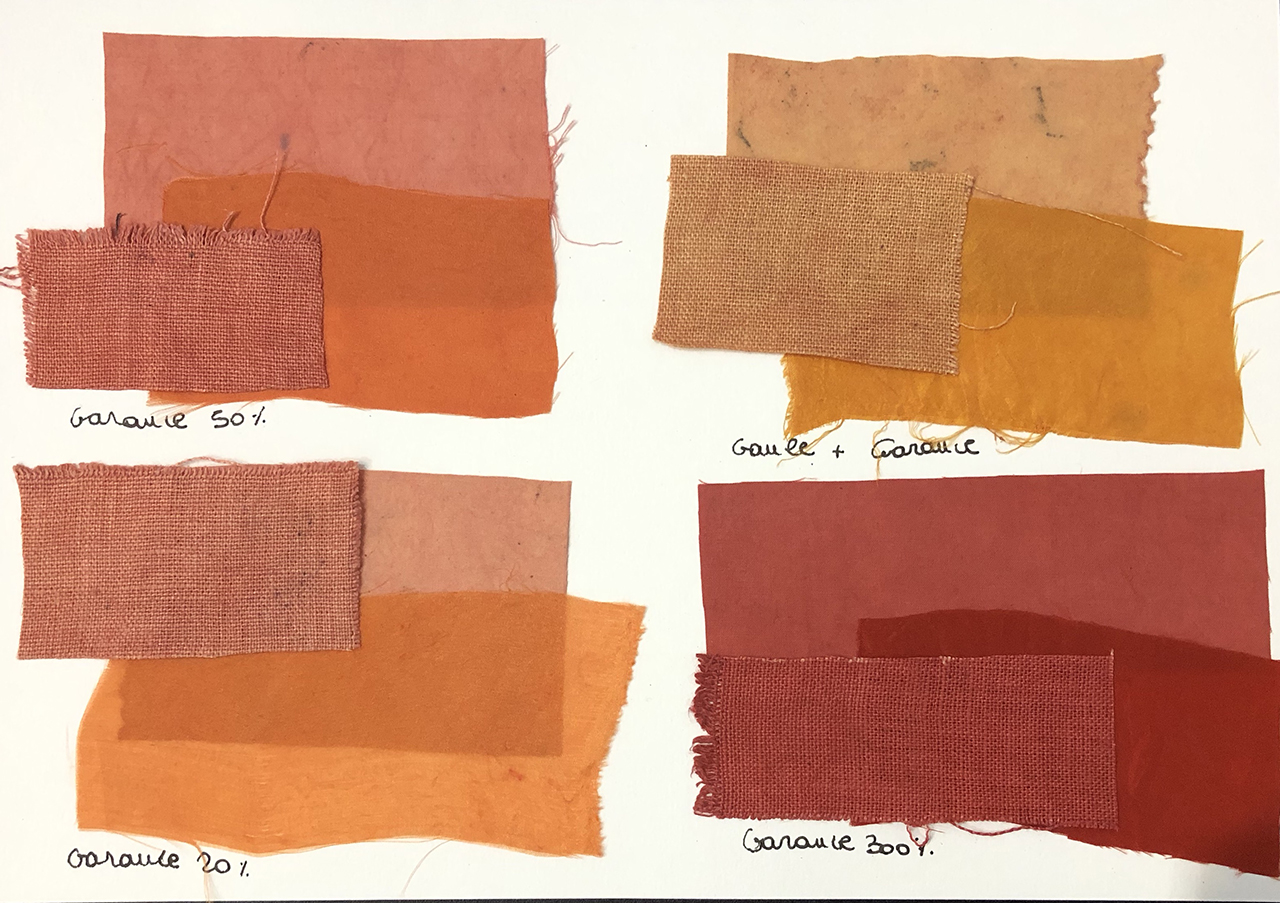
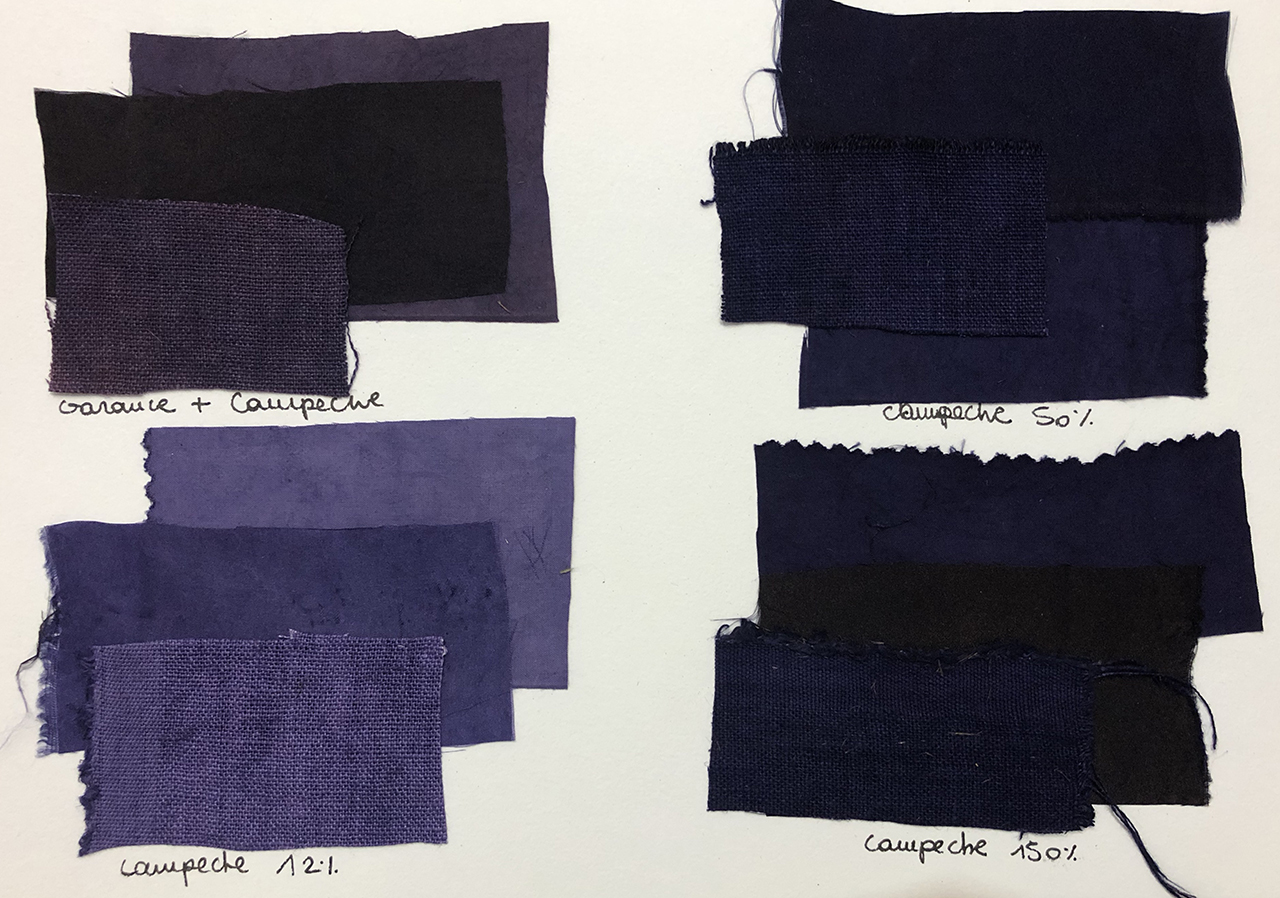



I'll describe each next samples:
1- For the next sample, first on the up-left:
- Linen, printed with with inks of nut husk, oignon and garance, and dyed with a rest of bath from oignon.
Sample at the bottom and on the right:
- silk, dyed with Garance, Santal and Oignon baths.
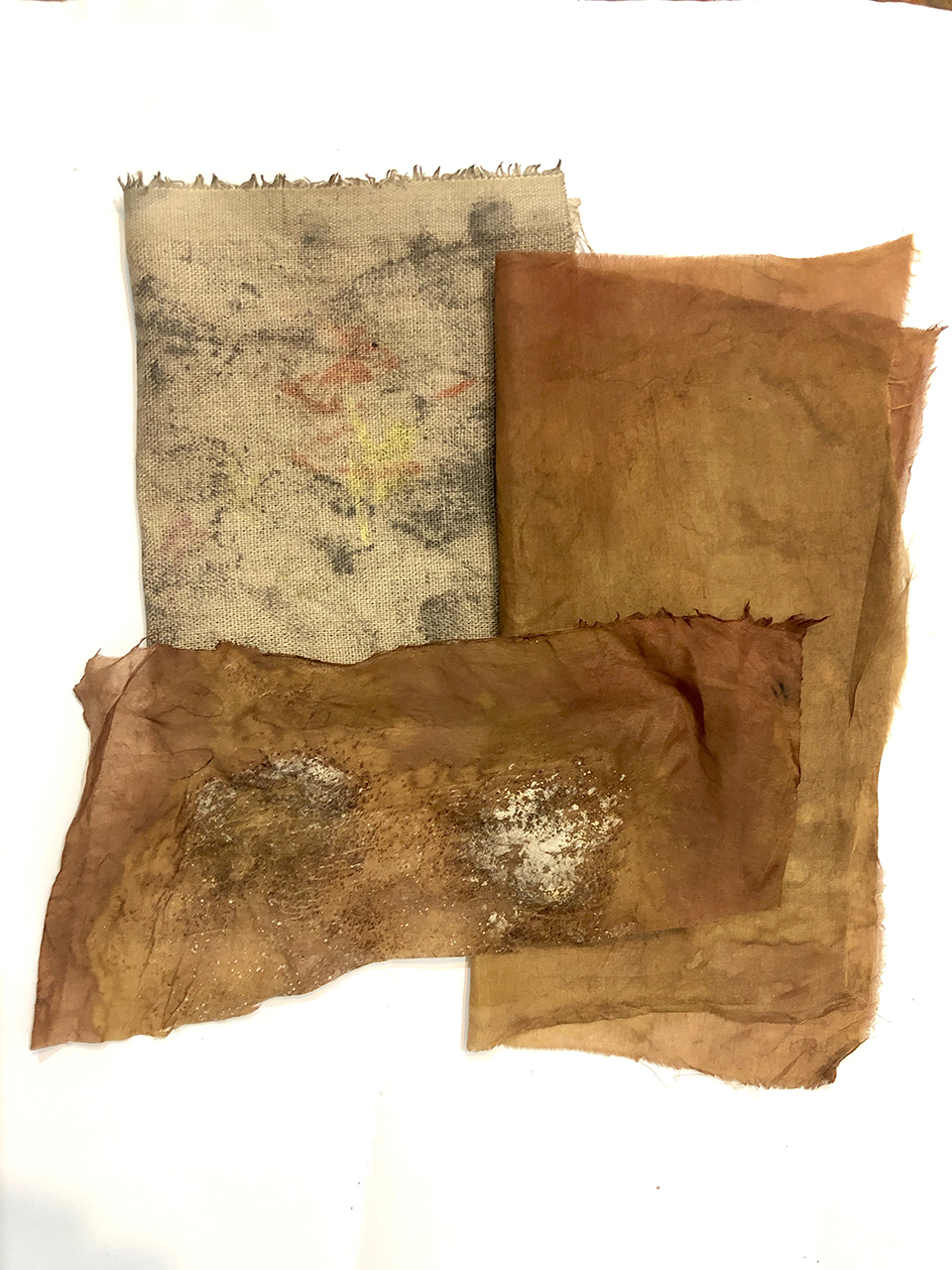
2- First sample on the top:
- Silk with ecoprint of Campeche wood and plants from the garden
Second sample:
- Screen printing of nut husk and campeche and grana cochinilla and campeche dye
Third sample:
- Cotton with ecoprint of Campeche wood and plants from the garden
Forth sample:
- silk with screen printing of campeche, grana cochinilla and garance.
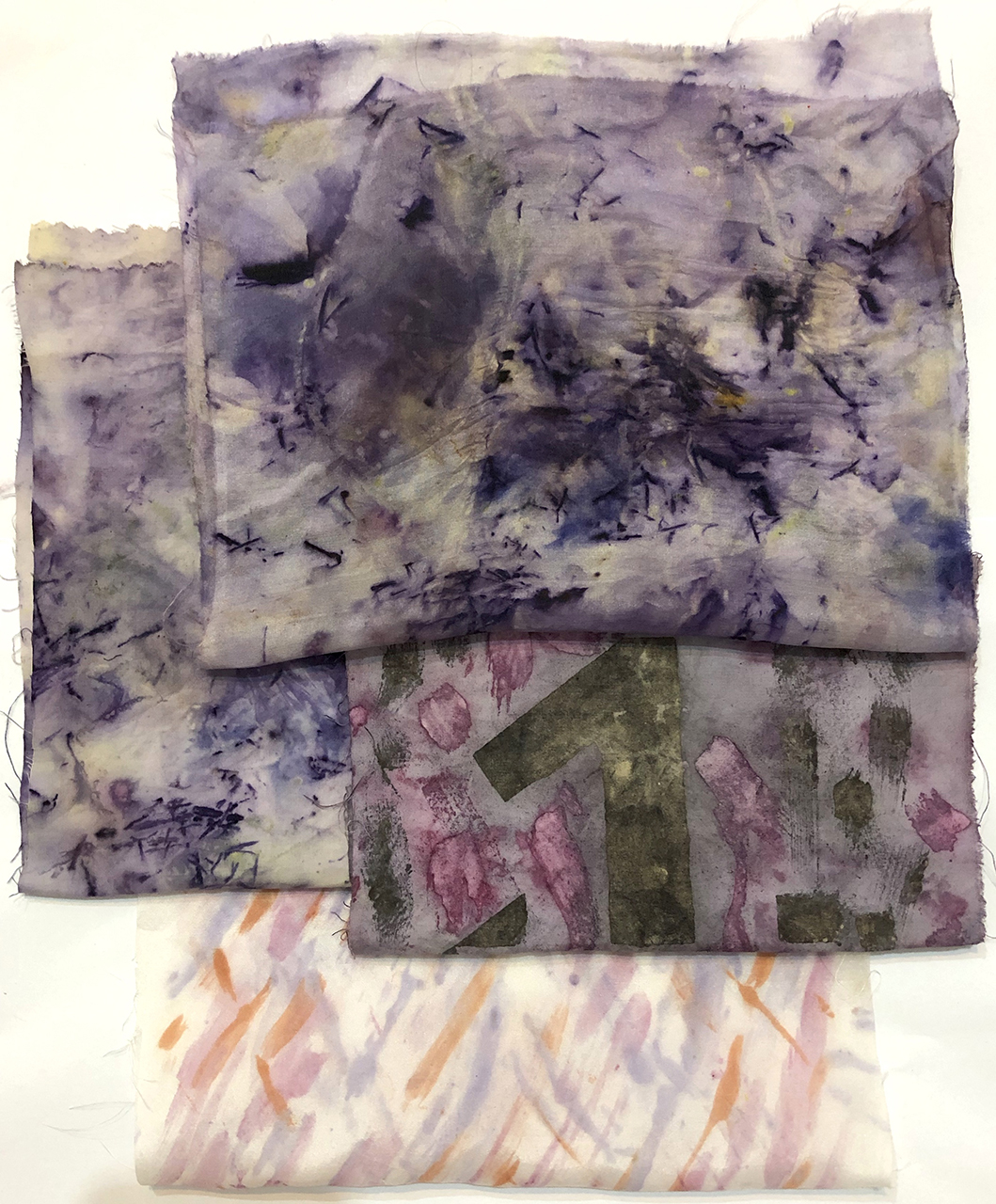
3- sample
- Screen printing with nut husk, onion, campeche, grana cochinilla, garance.

3D modelling of a character with a top, made on Blender:

This one is an experiment with all the different dyes and some of my hair
